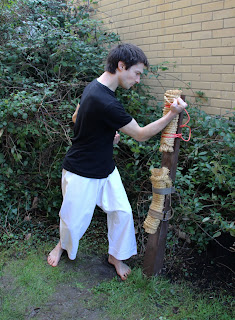The second demonstration of Master Funakoshi's Okinawan passai [shō] kata.
The Funakoshi Okinawan Karate Kenpo Kenkyukai (Research Society & Study Group) is dedicated to studying and researching, in particular, Master Gichin Funakoshi's Okinawan Shorin-ryu karate kenpo teachings. For authoritativeness, Master Gichin Funakoshi's old Okinawan karate, his later developed karate, Master Gigo Funakoshi's karate, the developments of Shoto-kai, & every other karate kenpo lineage, are all considered.
Saturday, 25 August 2018
Thursday, 23 August 2018
Okinawan Funakoshi Passai [Dai] (2) (Alternative)
The second demonstration of Master Funakoshi's Okinawan passai [dai], illustrated here as an alternative to the first in that a few movements can be performed in more than one way, as taught to me.
Old Okinawan Funakoshi Passai [Dai] (1)
The first illustration of Master Gichin Funakoshi's Okinawan passai [dai] kata.
In Funakoshi passai [dai], the first and last position, being the same, is a version of the palm-over-fist gesture which is derived from Chinese culture and means "to stop fighting". This is significant, as it illustrates the meaning of karate kenpo in the most simple fashion. These positions, like in the beginning of naihanchi, are not for technical applications. That is the opposite of their meaning. It would be against the essence of Okinawan boxing to apply these postures to fighting, regardless of if they are used for defence. Karate / karati is Okinawan and Chinese, and old Okinawan culture was (is) heavily, though not entirely, Chinese-influenced; kara-ti is karate kenpo or Ryukyu kenpo as in it is the Okinawan style of Chinese boxing, basically.
Wednesday, 22 August 2018
Funakoshi Karate Hojo Undo
Some examples of supplementary training in Master Gichin Funakoshi's karate, including iron-body methods such as the makiwara (machiwara), striking gravel with the finger-tips, hitting yourself with your arms and hands as well as with bamboo, conditioning the toes, applying dit da jow (medicinal "fall-hit wine"), and using a stone rolling-pin, and training with testu-sashi (iron kettle-bells in place of padlocks), tiger-style press-ups, and movement and stance training.
Sunday, 19 August 2018
Okinawan Funakoshi Sesan Kata (4)
A further illustration of Funakoshi Ryūkyū kenpō sēsan kata. An alternative to the other sēsan demonstrations, performed here without a top as is often traditional in Okinawan boxing.
Okinawan-style Funakoshi Sesan Kata (3)
Another demonstration of Master Gichin Funakoshi's Okinawan sēsan kata.
Saturday, 18 August 2018
Monday, 6 August 2018
Karate Research in Italian: Translation of "The Okinawan Origins of Japanese Shotokan Karate"
Some of my work is and will be available in Italian, translated by Alessandro Mario Rebuscini and published on his website. His idea was that he wants to make English-language karate-research accessible to Italians. I welcomed the initiative, as the point is to try to involve as many interested people as possible in this project and others from other researchers. The aim should be to bring all relevant parties together to move along the same track. Please follow the link below for the first translated article from my work. The original edition of this piece was published in July 2014 in issue 120 of Shotokan Karate Magazine.
Subscribe to:
Comments (Atom)
